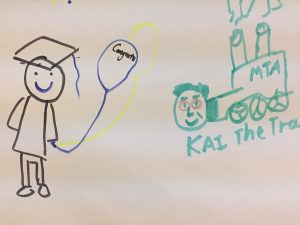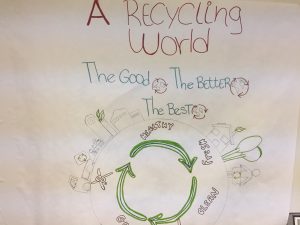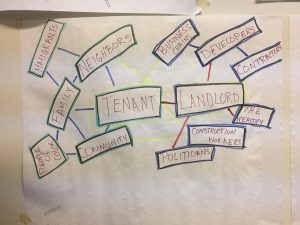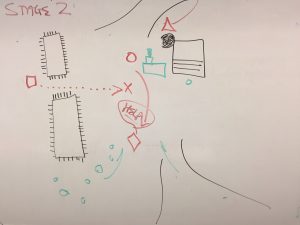




 Performance Intervention and Documentation (Final Project)
Performance Intervention and Documentation (Final Project)
Working in teams, students will choose an urban location where a specific environmental, economic, or human rights issue needs addressing. First, students will identify the connection between the local man made objects, technologies, and activities that threaten quality of human life and/or the natural world. Next students will compose a research question that will reveal information about the physical elements of the site and generate data related to inequalities and dangers. Using the archive of current and historic strategies and interventions for inspiration, students will create and participate in a live, public performance event that takes place at the site of investigation.
Individual Contributions: Each student needs to contribute to the team projects in all stages: research, performance, documentation, and final in-class presentation. During final presentations at the end of the semester, each member of the group needs to present on one aspect of the project for 4-5 minutes (in other words, each group of four members will have up to 20 minutes to present their material to the rest of the class). There will also be time for questions and discussion after presentations. One member of each group could be assigned to field questions and lead a post-presentation discussion.
Final Project Components:
Annotated Bibliography
Use your annotated bibliography to record research conducted on the history of the selected issue, the architectural aspects of the place where the performance occurs, and performative strategies used. Include a minimum of 2 sources per group member. MLA format.
Consult assignment guidelines and template for more details.
10% of final grade
Annotated Bibliography Rubric
- 25% Quality and relevance of sources
- 25% Formatting of bibliography & citations
- 25% Execution of critical summary
- 25% Analysis of sources in relation to project topic
Performance
In order to be successful, the performance must:
1) Be designed to incite change, generate awareness of, or create a critical conversation about the misuse of resources and the environment and the resulting negative effects on human life and society
2) Thematically and theatrically incorporate the designed and natural elements of the site into the performance itself
Consider: Who is your audience (those responsible for the misuse of place or those potentially affected by the misuse)? What is the specific goal of your performance (raise awareness, produce tangible change, inspire participation)? How can you use the materials and structures of the space in the performance to engage with the issues and your audience? What theatrical strategies and creative methods can you devise that will make your message impactful and memorable? What is each team member’s role in the performance and how do you collaborate effectively to utilize each person’s skills and produce a successful event? Finally, how do you encourage participation, either as part of the performance or after the event as actors in the social arena?
10% of final grade
Documentation and OpenLab Project Site
A section of an OpenLab project site will be created by each group, containing
an introduction to the project, a summary of research findings, an annotated bibliography and citations for all additional sources consulted, planning and promotional documents related to the performance event, documentation of the live event in the form of a photo essay, and anticipated outcomes of your performative intervention including the impact on audiences and the urban environment.
10% of final grade
In-class Presentation
Each group will prepare a 20-25 minute presentation on their final project. You should display your work on OpenLab project site and discuss all the elements there. Every member of the group must participate in the presentation. Importantly, the presentation is a moment to conduct a reflection on the different stages of development, performance, and documentation. Think about the successes and shortcomings of the performance. Why were certain aspects successful and why did certain aspects fall short of expectations? What might you have done differently if you could do it again? The presentation is not about convincing the audience that the performance was a complete success. Rather, it is about showing that you can think critically about your own work.
Preparation:
- Create speaking notes: a bullet-point list of topics on a piece of paper so you don’t go off topic while speaking.
- Use concepts from the course readings and lectures to conduct a meta-analysis of the development, performance, and documentation process. Cite specific readings, guest lectures or site visits to frame your observations or make comparative analyses.
- Time yourself and practice presenting ahead of time. Five minutes will seem longer when you are speaking in front of a group of people. You also want to practice to make sure you are staying on topic and you are able to express everything you need to say in the period of time provided.
- Work collaboratively. Make sure each member in your group understands their role.
10% of final grade
Grading Rubric for Peformance, Documentation, and Presentation
RESEARCH
| 25 | 22 | 19 | 16 | |
| To what degree did the group research and understand the particular site of intervention, performance tactics, and the target issue? | Excellent in all areas. Relevant and appropriate materials used. Research was well integrated into the performance and / or documentation. | Very good demonstration of research ability. Some minor gaps in research and sources could be better integrated into performance and / or documentation. | Average demonstration of research ability. Some sources are not appropriate or a good fit for the project. Integration of research into performance and / or documentation needs improvement. | Poor in all areas. |
SPACE AND PERFORMANCE
| 25 | 22 | 19 | 16 | |
| How well did the site of intervention support the performance, in terms of appropriate audience, choreography, sound, and use of space? | Excellent. Creative use of space and performance materials. Relationship between performance, space, and issue are clear. Strong engagement with audience. | Very good use of space and performance materials. The choice of performance space is logical. Engagement with audience is good. | Average creativity. Choice and use of performance space is decent, but uninspired. Minimal engagement with audience. | Poor in all areas. |
CRITICAL RESPONSE
| 25 | 22 | 19 | 16 | |
| How well did the group summarize their experience and analyze the effects of their intervention, particularly by engaging concepts from the course readings and seminars? | Excellent. Students expertly used concepts discussed in class to reflect on their experience and evaluate the impact of their performance. Students consider audience reactions and potential social outcomes. | Very good. Students incorporated concepts from the course in their self-reflection. Impact on audience is considered on a basic level. Connections made between performance actions and potential benefits to society. | Average. Minimal use of concepts from the course. Average level of self-reflection. Cursory examination of audience impact. | Poor in all areas. |
DOCUMENTATION
| 25 | 22 | 19 | 16 | |
| How effectively did the group document the event with audio, video, podcast, and/or text? How effectively was that material organized on OpenLab, presentation slides, social media, etc.? | Documentation was complete and appropriate to the performance. Site was well organized and designed. | Very good. Documentation was appropriate and complete. Information on the site was discoverable. | Average. Documentation method was not a great fit for the project or elements were missing. Site design and organization could be improved. | Poor in all areas. |



